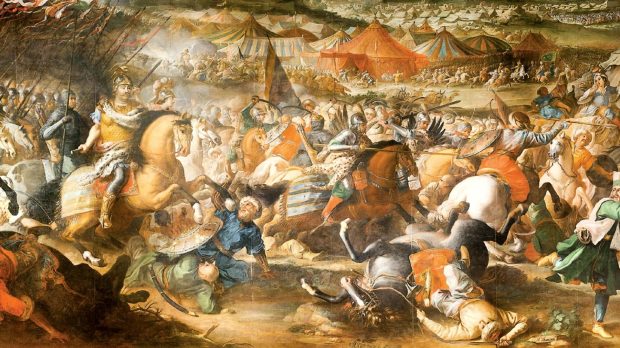Lenten Campaign 2025
This content is free of charge, as are all our articles.
Support us with a donation that is tax-deductible and enable us to continue to reach millions of readers.
In art, especially in painting and drawing, the model is often an unsung hero. Often, the human being upon whom an artist bases his depiction of the human form is anonymous. Sometimes, however, the model is well known.
According to at least one literary observer, the model for a band of soldiers in J.R.R. Tolkien’s Lord of the Rings was an actual fighting force who fended off the Ottoman invasion of Europe in the 17th century.
In 1529, Sultan Suleiman I the Magnificent was “riding high,” writes Jonathon Van Maren at his blog The Bridgehead. “He had been racking up victories across the continent, and decided that the first great conquest that would lead to his domination of Europe would be the magnificent city of Vienna. He boasted that he would be having breakfast in St. Stephen’s Cathedral within two weeks of the siege. When the date came and went, Vienna’s defenders, a coalition that included German Landsknechts, Spanish Musketeers, and Italian mercenaries, both Catholic and Protestant, sent the sultan a message to let him know that his breakfast was getting cold. Fierce defenders and savage weather eventually drove the Ottomans back, and Christian Europe, for the time being, was safe.”
But the Ottomans didn’t give up so easily. They made a second attempt in July of 1683, under the leadership of “Black” Mustafa, the Empire’s grand vizier.
“They arrived to lay siege to the city, demanding surrender,” Van Maren writes. “Count Ernst Rudiger von Starhemberg, the commander of Vienna’s garrison, scorned the ultimatum: ‘Let them come; I’ll fight to the last drop of blood.’ As the siege dragged on and hunger and exhaustion began to fell the city’s inhabitants, it began to look as if the defenders might have to do just that. Frantic pleas for assistance were sent out to the leaders of Christian Europe, calling for men and arms to repel the invaders. The calls were heeded, and a massive relief force made up of soldiers from Saxony, Baden, Franconia, Bavaria, Swabia, and Poland began to move towards Vienna.”
The battle, a chaotic, bloody affair, began on September 11, 1683—but there is one moment that stands out, immortalized against the backdrop of an epic struggle between civilizations. As Black Mustafa and the Turks tried desperately to force their way into the city before the relief troops could swing the advantage [to] the defenders, the Polish King Jan Sobieski emerged from the forests on the hills above the Ottoman attackers. At 6 PM, at his command, an awe-inspiring cavalry charge plunged over the crests of the hills and pounded towards the invaders, a magnificent force of 18,000 horsemen. The Polish king, at the head of 3,000 heavy lancers known to history as the Winged Hussars, led the charge. These knights were named for the wings of birds of prey attached to the backs of their armor, which streamed behind them in the wind and made them resemble a cloud of avenging angels. The Winged Hussars and the thousands of cavalrymen that followed them smashed into the Ottomans, trampling many of them to death. By the time the horsemen hammered down the hill, many of them were simply riding too fast to stop, and they cut through the enemy troops like a battering-ram of horse, man, and steel. The charge proved to be the fatal blow to the Ottoman siege, and the battle to save Vienna was won within three hours.
Made for Hollywood, you might say? Well, as a matter of fact, the dramatic saving act of the battle was noticed by none other than J.R.R. Tolkien, and he incorporated it into The Return of the King. The Battle of Pelennor Fields, the struggle for the city of Minas Tirith between the soldiers of Gondor and the forces of the Dark Lord Sauron, is based on the charge of Sobieski and his Winged Hussars.
Tolkien sets the scene with chilling foreboding: “It was dark and dim all day. From the sunless dawn until evening the heavy shadow had deepened, and all hearts were oppressed. Far above a great cloud streamed slowly westward from the Black Land, devouring light, borne upon war; but below the air was still and breathless, as if all the Vale of Anduin waited for the onset of a ruinous storm.” As the battle began in earnest, King Theoden emerges from the forest ahead of his cavalry, the fearsome Rohirrim. As he contemplates the destruction of the city, the king hears a booming sound from Minas Tirith, and suddenly stands erect: “Tall and proud he seemed again; and rising in his stirrups he cried in a loud voice, more clear than any there had ever heard a mortal man achieve before: Arise, arise, Riders of Théoden! Fell deeds awake, fire and slaughter! spear shall be shaken, shield be splintered, a sword-day, a red day, ere the sun rises! Ride now, ride now! Ride to Gondor! “With that, he seized a great horn from Guthláf his banner-bearer, and he blew such a blast upon it that it burst asunder. And straightway all the horns in the host were lifted up in music, and the blowing of the horns of Rohan in that hour was like a storm upon the plain and a thunder in the mountains.”
The models for Tolkien were heroes indeed, but not unsung.

